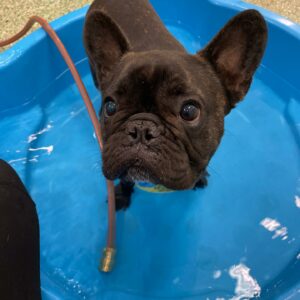Summer is here and with glorious days and extended daylight it’s a great time to soak up the sunshine and get outdoors with your pet. While you’re having fun in the sun, it’s important to ensure your dog stays cool and hydrated to keep them comfortable, and reduce the risk of overheating and exhaustion.
Dogs that are unable to cool themselves can develop heatstroke which can be life-threatening. Fortunately, there are many things you can do as a responsible dog owner to keep your dog cool and happy this summer which we’ll discuss in this article.
What causes heatstroke in dogs?
Heatstroke is caused when the body overheats for a prolonged time and causes failure of the body’s temperature-regulating mechanism. Dogs, unlike humans, do not have sebaceous (sweat) glands which means they cannot sweat to cool themselves down. This makes them more prone to overheating and developing heatstroke, which can be fatal if untreated.
Dogs rely on panting to cool themselves down as it helps to lower their body temperature. Unfortunately, it is not as effective as sweating, taking off layers of clothing (dogs coats are a little more attached than ours!) having a cold shower, or turning on the air-con.
Dog breeds with short snouts, like Pugs and Bulldogs, are at higher risk of getting heat stroke, as are older dogs, overweight dogs, and dogs that have had airway or heart problems.
Heatstroke can cause damage to lungs, organs, muscles, swelling of the upper airways, bleeding disorders, permanent brain damage and even death if left untreated.
What are the signs of overheating in dogs?
Overheating in dogs is a very serious and potentially life-threatening condition. One of the easiest ways to help reduce the risk of  overheating is awareness; you must be able to recognise the signs and symptoms of overheating in dogs. If you’re able to catch the signs early, there are steps that can be taken to treat and prevent the condition from worsening.
overheating is awareness; you must be able to recognise the signs and symptoms of overheating in dogs. If you’re able to catch the signs early, there are steps that can be taken to treat and prevent the condition from worsening.
The following are some of the most common signs and symptoms of overheating in dogs:
- Heavy panting – panting is a normal dog behaviour for cooling themselves off; however, excessive panting can be a sign of overheating
- Rapid heartbeat – A dog’s normal heartbeat is between 120-160 beats per minute; anything above that can be a sign of overheating
- Excessive drooling from the mouth
- Very red or dark tongue and gums
- Increased body temperature
- Drowsiness or weakness
- Staggering or collapsing
- Vomiting or diarrhea
- Excessive thirst
Tips to prevent heat stroke in dogs
Following are some steps you can take to ensure your dog stays cool in the heat of the summer, and minimise the risk of heat stroke:
- Maintain proper hydration – ensure your dog always has plenty of water available and top up their water bowls regularly throughout the day. Also, take a water bottle with you when going out for a walk. If you’re away from home for extended periods, put ice cubes in their water bowls to keep it cold.
- Avoid exercising your dog during the hottest parts of the day – try to walk them during the early morning or late evening when the sun isn’t as strong and there is less humidity in the air. If you must walk your dog during the day, make sure you do so in shaded areas. Also, remember that a footpath that is hot to the touch for your hands can burn your dog’s footpads.
- Stay indoors as much as possible – If you have a dog who likes to spend a lot of time outdoors, try to limit outdoor playtime to the early morning or late afternoon when the sun isn’t as strong.
- Create a shaded area outside – if your dog will be spending prolonged time outside, it’s a good idea to have a shaded area for them to rest in to help them stay as cool as possible.

- Use a cooling mat – There are cooling mats on the market that you can place in your dog’s bed that will help keep your dog cool when indoors, or place inside their kennel when outdoors.
- Set up a paddling pool – this is a fun way to help your dog cool off! Make sure the water is shallow and always supervise, especially if you have children at home too.
- NEVER leave your dog in a warm or hot car and don’t travel with your dog in a poorly ventilated car. Turn your car’s air conditioning on when travelling.
When it comes to reducing the risk of overheating, prevention is key. Heatstroke, in particular, is something that can happen extremely quickly. Therefore, it is a good idea to be proactive when it comes to protecting your dog from heatstroke. Always keep an eye out for warning signs. If your dog seems lethargic, is panting excessively, or doesn’t want to play outside as much, it could be a sign that your dog is overheating.
If you notice any signs of overheating in your dog, it’s best to take them to the vet as soon as possible. If you suspect your pet has heatstroke, you can attempt to cool them using cool water, not ice, over their body until you get to a vet.